1996 PONTIAC GRAND-AM coolant level
[x] Cancel search: coolant levelPage 116 of 356

Low Coolant Warning Light
; I’ ,.
If this light comes on and
stays on, the vehicle should
be promptly pulled
off the
road and the coolant level
checked.
See “Engine
Coolant”
in the Index.
Malfunctilon Indicator Lamp
(Check Engine Light) ~ ..
0
CHECK
Your Pontiac is equipped
with a computer
which
monitors operation of the
fuel, ignition and emission
control systems.
If there are visible signs of steam see “Engine
Overheating” in the
Index before opening the hood. , . ’? --+ -- This system is called OBD I1 (On-Board .>. ’ I .;: . , Diagnostics-Second Generation) and is intended to
.-. . assure that emissions are at acceptable levels for the
life of the vehicle, helping to produce a cleaner
environment.
(In! Canada, OBD 11 is replaced by
Enhanced Diagnostics.) The CHECK ENGINE light
comes on to indicate that there is a problem and service
is required, Malfunctions often will
be indicated by the
system before
any problem is apparent, which may
prevent more serious damage to your vehicle. This
system is
also designed to assist your service technician
d . in correctly diagnosing any malfunction.
.. .? ’. .. .- . .. i - ,, , c < -. , ,. t :. . ‘7 -n. 9’ .! , . ‘i :- -:x: :, -’ ::;.- . b- .. ,- , . .. .. . : .. -. I. . :. ‘1 .’ ’ E -, . - . r_ :. .. . I. , I -.. . I .C . .. . . .. . .-..-‘ >: =: , , ‘. .. -; T‘.
’ ““2-60
ProCarManuals.com
Page 124 of 356
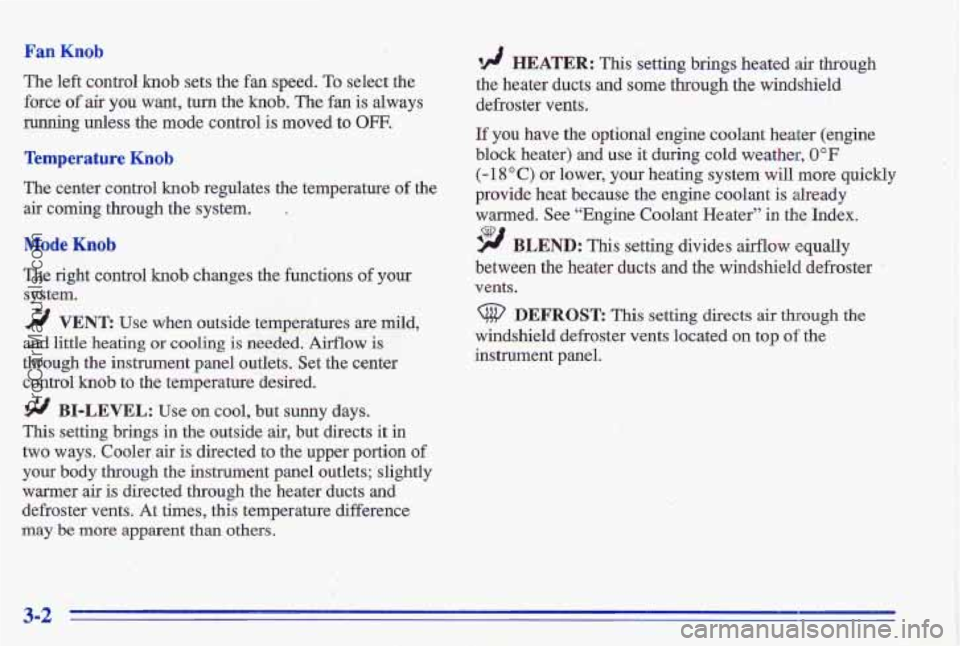
Fan Knob
‘The left controlknob sets the fin speed. To select thle
force
of air you want, turn the knob. The fan is always
runhing unless the mode control is moved to OFF.
Temperature Knob
The center control knob regulates the temperature of the
air coming through the system. ,
Mode Knob
The right control knob changes the functions of your
system.
2 VENT Use when outside temperatures are mild,
and little heating or cooling is needed, Airflow is
through the instrument panel outlets. Set the center
control
hob to the temperature desired.
9 BI-LEVEL: Use on cool, but sunny days.
This setting
brings in the outside air, but directs it in
two
ways. Cooler air is directed to the upper portion of
your body through the instrument panel outlets; slightly
wanner
air is directed through the heater ducts and
defroster vents. At times, this‘temperature difference
may be more apparent than others,
d HEATER: This setting brings heated air through
the he’ater ducts and some through the windshield
defroster vents.
If you have the optional engine coolant heater (engine
block heater)
and use it during cold weather, 0°F
(- 18 O C) or lower, your heating system will more quickly
provide heat be’cause the engine coolant is already
warmed. See “Engine Coolant Heater” in
the Index.
9 BLEND: This setting divides airflow equally
between the heater ducts
and the windshield defroster ’
vents.
DEFROST
This setting directs air though the
windshield gefroster vents located on top of the
instrument panel,
3-2
ProCarManuals.com
Page 126 of 356
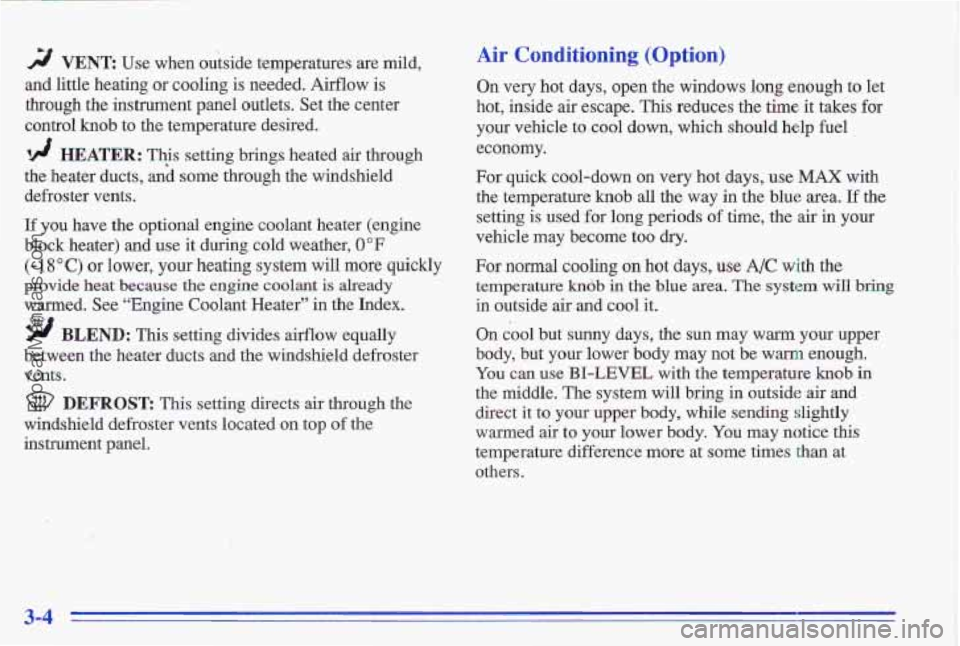
rF/ VENT Use when outside temperatures are mild,
and little heating or cooling is needed. Airflow is
through the instrument panel outlets. Set the center
control
knob to the temperature desired.
‘!! HEATER: This setting brings heated air through
the heater ducts, aid some through the windshield
defroster vents.
If you have the optional engine coolant heater (engine
block heater) and use it during cold weather,
0°F
(- 1 8 O C) or lower, your heating system will more quickly
provide heat because
the engine coolant is already
warmed. See “Engine Coolant Heater”
in the Index.
9 BLEND: This setting divides aeflow equally
between the heater ducts and the windshield defroster
vents.
DEFROST This setting directs air through the
windshield defroster vents located on top of the
instrument panel.
Air Conditioning (Option)
On very hot days, open the windows long enough to let
hot, inside air escape. This reduces the time it takes for
your vehicle to cool down, which should help fuel
economy.
For quick cool-down on very hot days,
use MAX with
the temperature
knob all the way in the blue area. If the
setting is used for long periods
of time, the air in your
vehicle may become too dry.
For normal cooling on hot days, use A/C with the
temperature
kndb in the blue area. The system will bring
in outside air and cool it.
On cool but sunny days, the sun may warm your upper
body, but your lower body may not be warm enough.
You can use BI-LEVEL with the temperature knob in
the middle. The system will bring in outside air and
direct it to your upper body, while sending slightly
warmed air
to your lower body. You may notice this
temperature difference more at some times than at
others.
3-4
ProCarManuals.com
Page 205 of 356
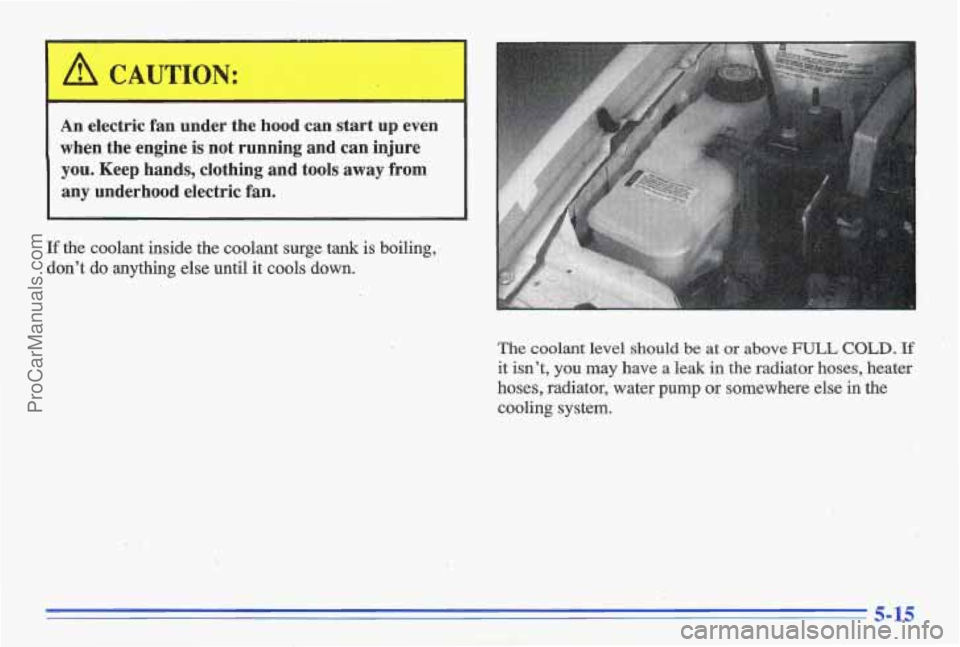
' A CAUTION:
An electric fan under the hood can start up even
when the engine is not running and can injure
you. Keep hands, clothing and tools away from
any underhood electric
fan.
1
If tkie coolant inside the coolant surge tank is boiling,
don't
do anything else until it cools down.
The coolant level should be at or above FULL COLD. If
it isn't, you my have a leak in the radiator hoses, heater
hoses, radiator, water pump
or somewhere else in the
cooling system.
"I '!
_.
-. .
, :.' I' I1
ProCarManuals.com
Page 206 of 356
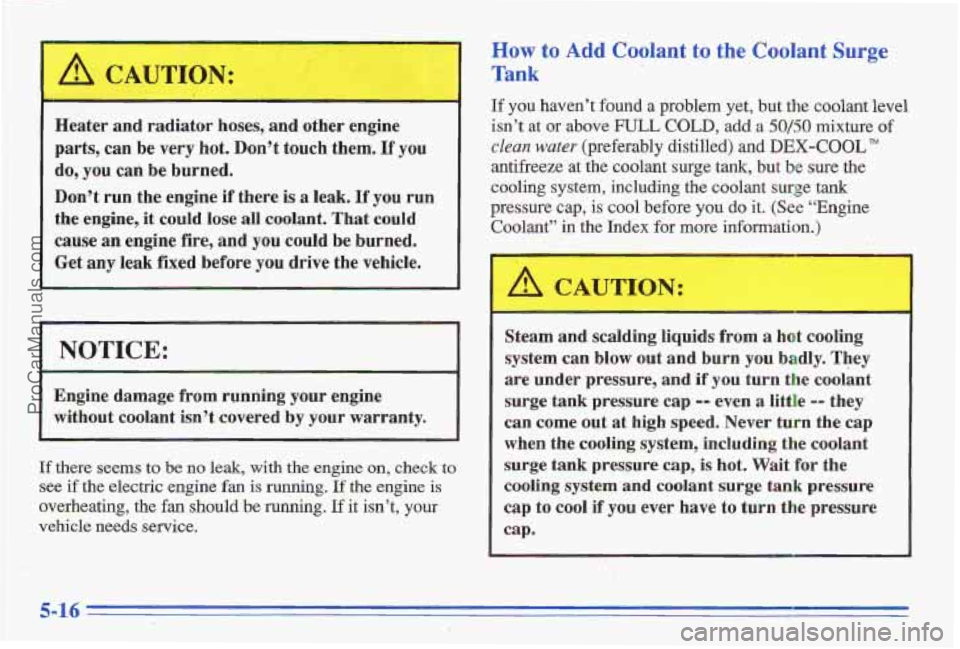
6!!l CAUTION:
~~~ ~
Heater and radiator hoses, and other engine
parts, can be very hot. Don’t touch them.
If you
do, you can be. burned.
Donst run the engine
if there is a leak. If you run
the engine, it could
lose all coolant. That coulld
cause an engine
fire, and you could be burned.
Get
any leak fixed before you drive the vehicle.
without coolant isn’t covered
by your warranty.
If there seems to be no leak, with the engine on, check to
see if the electric engine fan is running. If the engine is
overheating, the fan should be running. If it isn’t, your
vehicle needs service.
How to Add Coolant to the Coolant Surge
Tank
If you haven’t found a problem yet, but the coolant level
isn’t at
or above FULL COLD, add a 50150 mixture of
clean water (preferably distilled) and DEX-COOL
antifreeze at the coolant surge tank, but be sure the
cooling
system, including the coolant surge tank
pressure cap,
is COO^ before you do it, (See “Engine
Coolant” in the Index for more infomati .) - --
I
Steam and scalding liquids from a hot cooling
system can blow out and burn you badly. They
are under pressure, and
if you turn the coolant
surge tank pressure cap
-- even a little -- they
can come out at high speed. Never turn the cap
when the cooling
system, including the coolant
surge tank pressure
cap, is hot. Wait for the
cooling system and coolant
surge tank pressure.
cap to cool if you ever have to turn the pressure
cap.
5-16
ProCarManuals.com
Page 210 of 356
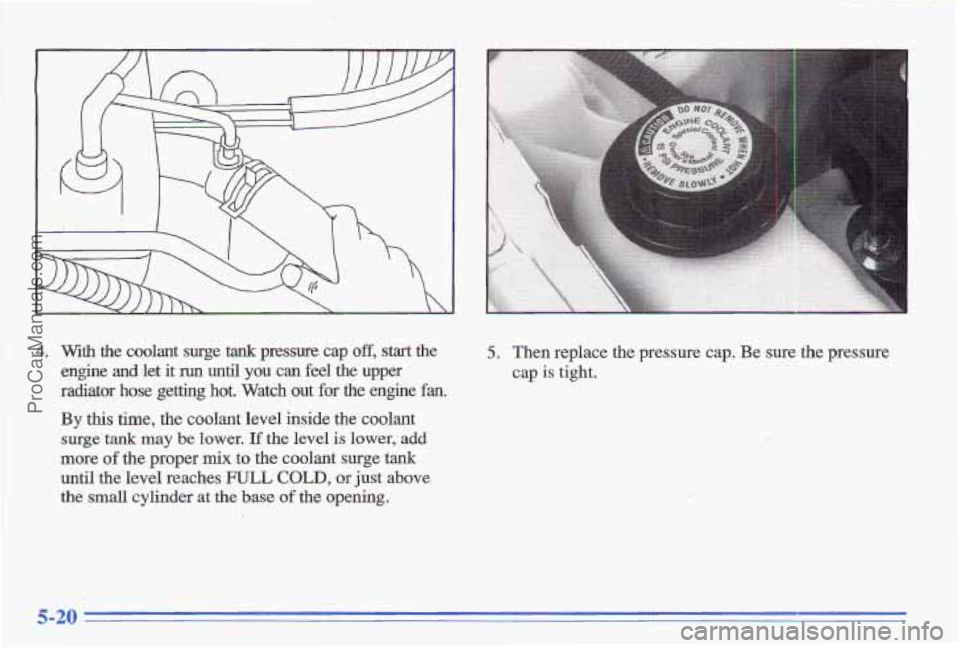
4. With the coolant surge tank pressure cap off, start the
engine and let it run until you can feel the upper
radiator hose
getting hot. Watch out for the engine fan,
By this time, the coolant level inside the coolant
surge tank may be lower. If the level is lower, add
more of the proper mix to the coolant surge tank
until the level reaches FULL COLD, or just above
the small cylinder at the base of the opening.
5. Then replace the pressure cap. Be sure the pressure
cap is tight.
ProCarManuals.com
Page 244 of 356
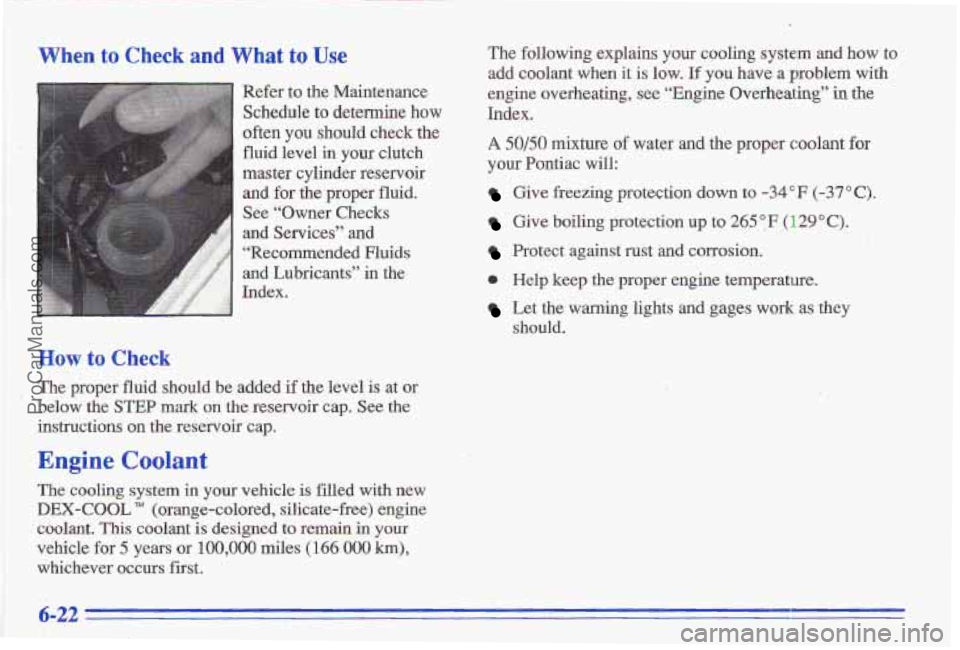
When to Check and What to Use
Refer to the Maintenance
Schedule
to determine how
often you should check the
fluid level
in your clutch
master cylinder reservoir and for
the proper fluid.
See “Owner Checks
and Services” and
“Recommended Fluids
and Lubricants” in the
How tu Check
The proper fluid should be added if the level is at or
below the
STEP mark on the reservoir cap. See the
instructions
on the reservoir cap.
Engine Coolant
The cooling system in your vehicle is filled with new
DEX-COOL TM (orange-colored, silicate-free) engine
coolant.
This coolant is designed to remain in your
vehicle
for 5 years or 100,000 miles (166 000 h),
whichever occurs first. The
following explains
your cooling system and how to
add coolant when it is low. If you have a problem with
engine overheating, see “Engine Overheating”
in the
Index.
A Sol50 mixture of water and the proper coolant for
your Pontiac will:
Give freezing protection down to -34°F (-37°C).
Give boiling protection up to 265 9 F ( 129 O C).
Protect against rust and corrosion.
0 Help keep the proper engine temperature.
Let the warning lights and gages work as they
should.
6-22
ProCarManuals.com
Page 247 of 356
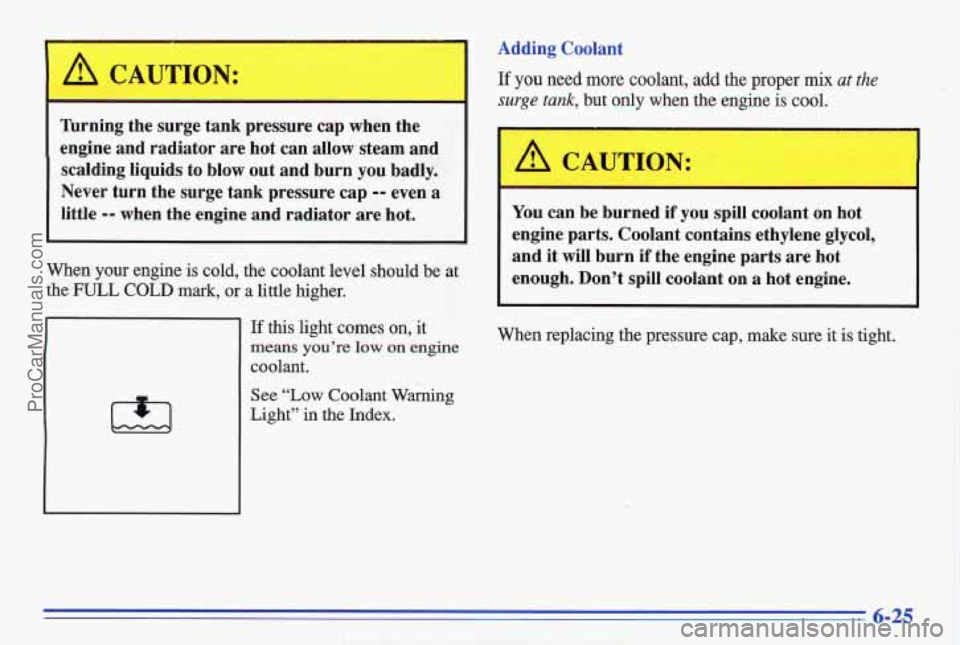
A CAUTION:
Turning the surge tank pressure cap when the
engine and radiator are hot can allow steam and
scalding liquids to blow out and burn you badly.
Never turn the surge tank pressure cap
-- even a
little -- when the engine and radiator are hot.
When your engine is cold, the coolant level should be at
the FULL
COLD mark, or a little higher.
If this light comes on,
means you’re low on engine
coolant.
See “LOW coolant Warning
Light” in the Index.
Adding Coolant
If you need more coolant, add the proper mix at the
surge tank, but only when the engine is cool.
I A CAUTION:
You can be burned if you spill coolant on hot
engine parts. Coolant contains ethylene glycol,
and it will burn if the engine parts are .hot
enough. Don’t spill coolant on
a hot engine.
~~
When replacing the pressure cap, make sure it is tight.
ProCarManuals.com